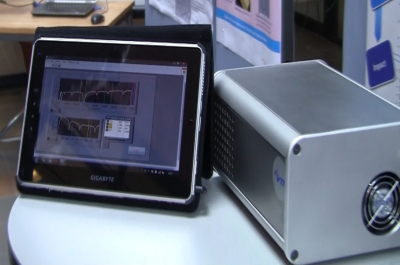
In the future, several illnesses will be able to be quickly and painlessly diagnosed by optical absorption spectroscopic analysis of isotopes contained in exhaled air. A prototype developed by VTT makes is possible to determine painlessly and with absolute certainty during a doctor’s appointment whether the patient’s stomach troubles are caused by Helicobacter. The certainty of the device is based on its ability to measure not only 13C but also 18O in exhaled air.
The instrument is based on a technology developed by VTT’s MIKES Metrology business, optical absorption spectroscopy in a multipass chamber with the sample volume reduced to just 40 µL. Due to the extremely small sample volume, the gas inside the chamber can rapidly be exchanged. This, in turn, enables the entire breathing cycle of the patient to be analysed rapidly by the same device.
Diagnosis methods based on respiratory air are a growing trend. In addition to Helicobacter, respiratory air can be used to analyse a person’s energy consumption and weight loss, early-stage Type 2 diabetes and blood poisoning or sepsis that cause considerable expenses to hospitals and is one of the main causes of mortality after the surgical operations.
VTT is planning follow-up projects intended to develop the device for diagnosing also other illnesses. The device can be used to analyse proteins and various chemicals. 17O can be measured as well. Because the device measures completely safe, stable isotopes, it can also be utilised by the food industry. The analyser also has possible applications in the monitoring of surgery patients and unconscious patients, because it can operate next to the patient around the clock. Accurate and specific data can be obtained from each breathing cycle.
“Researchwise, it is a significant step that we can now measure the ratios of both isotopes in real time”, states Albert Manninen from VTT.
VTT’s prototype includes a computer, a pump and optics, and it is operated with a single button. It communicates wirelessly with tablets and smartphones. The result of the measurement is displayed immediately.
Current commercial devices based on exhaled air analysis give a result with a 95–98% reliability, which means that the results must often be confirmed with gastroscopy, a procedure that is rather unpleasant for the patient. The device developed by VTT has the benefit of eliminating false positives from the analyses. According to a study published in 2014, a 100% analysis accuracy can be achieved when 18O is analysed from exhaled air in addition to 13C. The current commercial exhaled air analysers only perform the analysis on 13C.
Helicobacter can be detected in exhaled air when the 12C of a urea molecule is artificially replaced by 13C. This replacement is done by means of a harmless pill containing the urea chemical and swallowed by the patient. If there are Helicobacteria in the stomach, they will break down the urea molecules into carbon dioxide molecules that will then enter the patient’s system, finally travelling via the lungs into the exhaled air.
The device developed by VTT analyses the ratio between 13C and 12C in exhaled air. When the 13C ratio in exhaled air increases after taking the pill, it has been shown with 97% certainty that the patient is suffering from Helicobacter that can be treated with drugs. The difference in VTT’s device is that it also analyses the ratio of 18O in the exhaled air, which provides a 100% certainty for the diagnosis.
Spectrometry based on the analysis of isotopes has thus far been widely applied in medical analysis, because 13C is relatively easy to measure with a non-dispersive optical device. Detecting 18O is more difficult due to its significantly weaker absorption, and spectrally, it is located between the main isotope and 13C. Its detection requires mid-infrared lasers that have not been commercially available until the last few years.
Helicobacter pylori or Helicobacter is connected to several problems in the upper gastrointestinal tract, such as ulcers and gastritis. According to estimates, 30–40% of the population in the developed countries has the infection.
Diagnosis of the bacteria is unpleasant for the patient, as it requires a biopsy using gastroscopy, which currently means that the patient has to swallow a tube that is then used to take a sample from the stomach. The accuracy of the procedure depends on the skills of the person performing the procedure, and getting a diagnosis may take several days.

